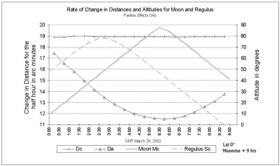
NavList:
A Community Devoted to the Preservation and Practice of Celestial Navigation and Other Methods of Traditional Wayfinding
Re: Parallactic retardation - don't give up so easily.
From: Fred Hebard
Date: 2004 Jan 10, 18:44 -0500
From: Fred Hebard
Date: 2004 Jan 10, 18:44 -0500
OK, There are three major components in calculating a time from a lunar. These are the cleared, observed distance, D, and the calculated distances for the whole hours before and after the lunar is shot, let them be d1 and d2, respectively. Using linear interpolation, the time is then (D-d1)/(d2-d1) plus the hour before the lunar. I'll discuss both the numerator (D-d1) and the denominator(d2-d1), starting with the denominator THE DENOMINATOR, (d2-d1) The difference between d1 and d2 varies from about 25 to 35 arc-minutes per hour. d1 and d2 are calculated entirely from ephemerides, such as one finds in the Nautical Almanac. No sextant observations enter into them at all. I argued previously, following Jan Kalivada, that any "parallactic retardation" would not affect the accuracy of d2-d1 if the ephemerides were accurate. In addition d1 and d2 are equivalent to cleared differences, as George Huxtable has pointed out recently. They are the distance between the center of the earth and the center of the moon, assuming there are no effects from refraction, semidiameter, parallax, irradiance, ellipticy, etc. Those corrections only affect the clearing of the distance observed with the sextant. Previously, George was confounding the cleared and the uncleared values for d1 and d2. If you look at the "Parallactic retardation graphs" at http://www.ld-DEADLINK-com, you will see graphs of "Dc" and "Da." Dc is my (d2-d1), while Da is the uncleared difference. Only "Da" shows the effect of parallactic retardation whereas "Dc" is reasonably constant. This is the main point George has been telling us. I have taken the liberty of pasting one graph from that page into this post THE NUMERATOR, (D-d1) There is one important point concerning the numerator in our formula for calculating time from lunar distance observations. It is that the error in the observed distance, D, is generally a small part of the total distance and clearing changes the distance by only a small amount. So clearing an apparent sextant distance to get D does not change that error very much. Consider absolutely the worst case of a short distance and a large amount cleared off the distance. A typically short distance might be 25 degrees. After clearing it might become 26 degrees in extreme cases. The error, usually about 30 seconds of arc for observers of moderate proficiency, will also be altered by a similar amount. So that an error of 30 seconds of arc will become about 31.2 seconds of arc in extreme cases. Thus the cleared error will be insignificantly different from the uncleared error, considering that we can't measure to closer than 5 seconds of arc. It doesn't even matter whether the clearing process is additive or multiplicative. The clearing process is designed to get absolutely the best estimate we can of the distance, D, so that we can know it to an accuracy of 1 part in 15,000. We're not worried about the rate of change in the distance but about the distance itself. Our sextant error is that 1 part; we can't possibly know the "error of the error" to a similar degree; it doesn't matter whether the error is 1 or 1.1, which is an "error of the error" of 1 part in 10; both still amount to an error of 1 in 15,000. Our numerator will thus be in error by an amount almost identical to the error in the raw sextant observations, and the error in the time will be that error/(d2-21). DATA I ran some numbers through for worst-case scenarios of the now-debunked evil effects of parallactic retardation, and found no effect. For instance, I took times from Arthur Pearson's graph, "Equ Lagging Moon 1.JPG", accessed from http://www.ld-DEADLINK-com and pasted below, specifically 00:45:00 and 05:45:00, and a longitude of 75degrees W, with an assumed error of 30 seconds of arc. The difference between the cleared distances with and without the error of 30 seconds of arc increased from 30.3 seconds of arc to 30.5 seconds of arc. The difference in time estimates changed from 48 to 47 seconds of time. Thus there was no significant effect in this extreme case of parallactic retardation, as we would expect. In the case above, there was no change in Dc (equivalent to (d2-d1)) between the two times, which were only 5 hours apart. If you take observations well spaced in time, such as several days or longer, Dc can change considerably, which could account for some of the reported effects of parallactic retardation on time estimates.







